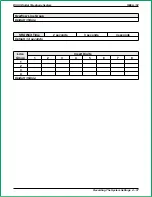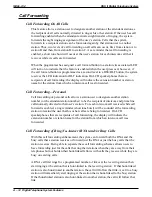
Account Codes (With Forced Positive Verification)
System users can employ account codes to identify calls by category or by any other
desired grouping so that the system can print reports. The account code entry can be
voluntary or the programmer can arrange the system so that the users are forced to enter
an account code before they can make an outgoing call. The system compares the
account code entered by a station user with a list of programmed account entries.
The programmer must program the system so that it verifies an entered account code as
valid. If he or she enables verification and the system cannot match an account code that
a user has dialed with the programmed account code entries, the system will sound an
error tone if account code
entry is voluntary, or it will prevent the user from further dialing until he or she enters a
matching account code if account code entry is forced.
A user must enter an account code either before dialing an outgoing call or after the
distant party on an incoming call has hung up. Additionally, users may enter an account
code before they select a line for an outgoing call if they wish. When they enter an
account code without a line selection, the code will apply to any line they subsequently
select at that station. On incoming and outgoing calls, the user who enters the account
code is associated with the call record except when the call is transferred. On transferred
calls, the transferee is associated with the call record.
As a feature to LCD speakerphone users, the programmer can arrange for a message to
appear in the telephone’s display to prompt the user to enter an account code during
incoming or before outgoing calls. He or she can also assign the length of time that the
display appears. The user must enter account code digits after the message appears. If the
programmer has set the system to verify code entry, it then makes a verification attempt.
If the system cannot verify the account code it causes the display to show an error
message. The user may then re-enter the account code at this point. If the verification
attempt is successful (or if the system does not require that the code be verified), the
display will return to its normal date and time message. If the account codes are forced
and the call is outgoing, then the line is dropped at the end of the display time if the user
has not entered a valid account code. The programmable range for the display time is 1 to
20 seconds. When the feature is not enabled, the system inhibits the display prompt.
When a station user activates the last number redial or automatic redial features for
outgoing calls, the system will automatically re-use the last account code the user entered
at that station unless he or she enters a new one before activating the redial feature.
In addition to turning on the account code feature, enabling its verification, and making it
either voluntary or forced, the programmer must set the account code length, specify the
number of digits that the system will verify, and make up the entire list of account codes
that the users will use. Account code length defines the number of digits that a user must
enter before the system will accept the code. The length can range from three to 16 digits
IMI66–132
DSU II Digital Telephone System
A – 2 Digital Telephone System Features
Summary of Contents for DSU II
Page 31: ......
















































